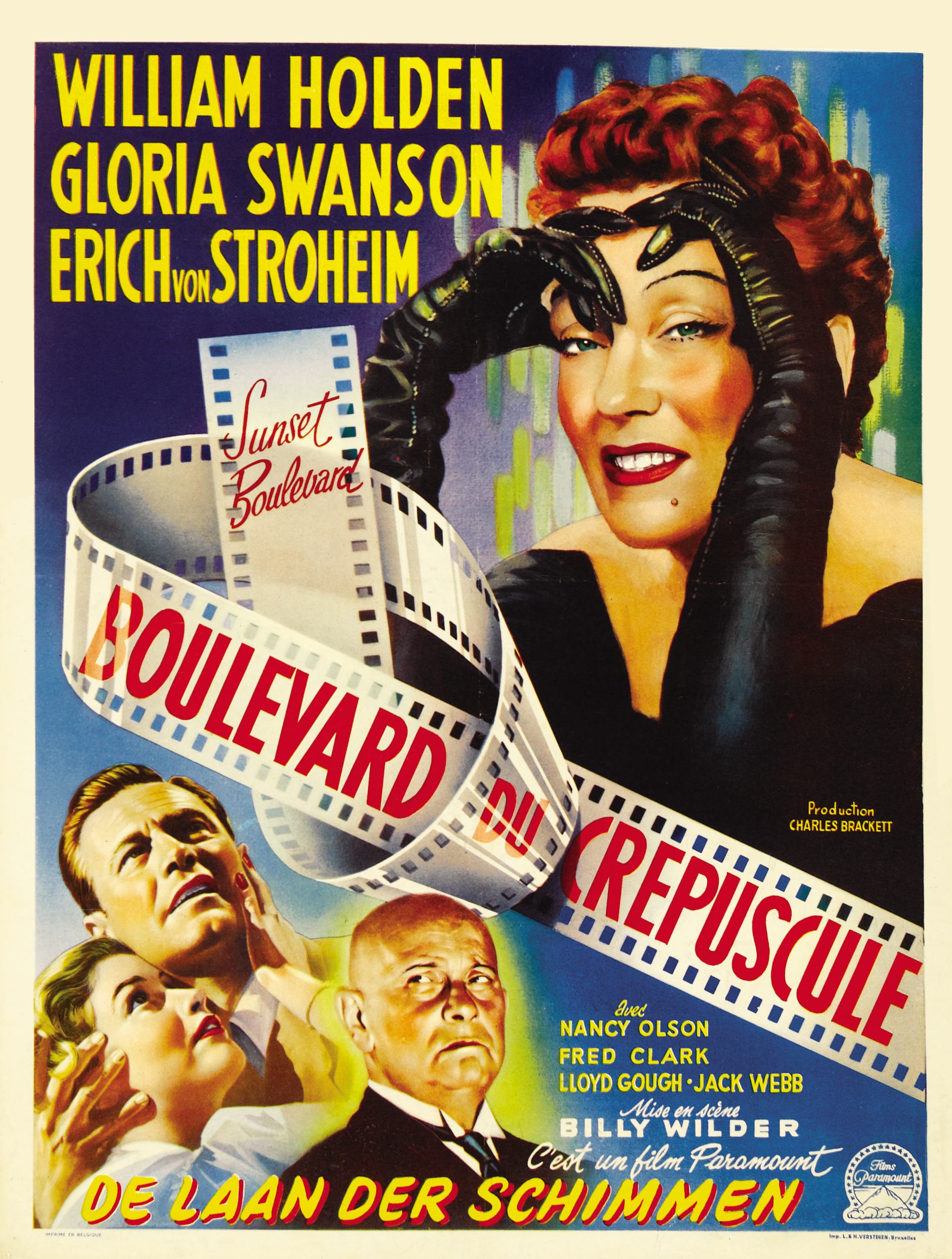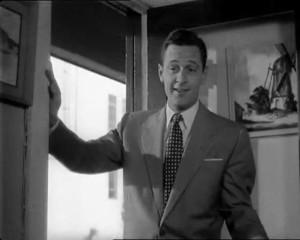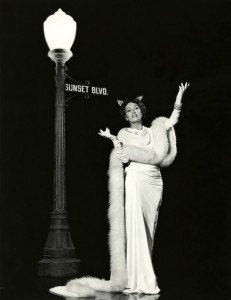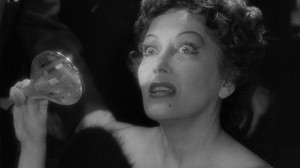Classic Movie Night: Sunset Boulevard (1950)

The film’s working title was A Can of Beans. Although most contemporary and modern sources refer to the film asSunset Boulevard, the opening title card is a street sign that reads Sunset Blvd. The opening scene of the film is accompanied by offscreen narration spoken by William Holden as his character, “Joe C. Gillis.” “Gillis” informs the viewer that the crime scene is situated on Sunset Blvd. in Los Angeles, CA, where the murder of a lowly screenwriter has occurred at the home of a major screen star. Although Gillis is the murder victim, he refers to himself in the third person. He then switches to the first person as the film flashes back to six months earlier.
Information in the file on the film in the MPAA/PCA Collection at the AMPAS Library reveals that as of May 1949, the final sequence of the script had not been submitted to the PCA for approval. In a letter to Paramount, PCA director Joseph I. Breen noted that “[t]he most recent of th[e] material seems to indicate the introduction of a sex affair between Gillis and Norma which was not present in the earlier material….[I]t seems to us at this point that there is no indication of a voice for morality by which the sex affair would be condemned nor does there appear to be compensating moral values for the sin.” By July 1949, however, the PCA determined that the completed script met the requirements of the Production Code.
The film originally opened with a scene in the Los Angeles morgue, where “Joe Gillis’” body has been placed, and closed with another morgue scene. In the original opening, “Gillis” talks with his fellow corpses, before narrating his own story. According to news items, the scene, which modern sources report was written solely by Billy Wilder because Charles Brackett found it too morbid, was included in preview screenings. However, when January 1950 preview audiences laughed during the opening, the film’s release was delayed by six months and the morgue scene was cut. Co-writers Wilder and Brackett dissolved their thirteen-year partnership after this film.
According to news items, Montgomery Clift was originally cast as Gillis, and Mae West was initially considered for the role of “Norma Desmond.” In a modern interview with Billy Wilder in The New Yorker, Wilder noted that the role of Gillis was written for Clift, who withdrew from the film just prior to production. According to modern sources, Fred MacMurray was considered for Gillis, but found the role unappealing. Marlon Brando and Gene Kelly were also considered, according to modern sources. After West declined the role of Norma Desmond, modern sources add, silent stars Pola Negri and Mary Pickford were sought. Swanson was fifty-one when she shot this film; although her film career began in 1915, she became famous in the 1920s, working frequently with director Cecil B. DeMille at Paramount. Swanson left the studio in 1928 to produce her own films, but lost a substantial sum of money on Queen Kelly, an extravagant production directed by Erich von Stroheim, who was fired by Swanson in mid-production because of his excesses. A portion of that film, which was not released in the United States, is seen in Sunset Blvd. Over one hundred early photographs of Swanson at the height of her career are also seen.

Although Swanson made a successful transition to sound films, she retired in 1934, and appeared in only one film before starring as Norma Desmond. Von Stroheim, originally an actor, became a renowned director, his most famous film being the 1925 M-G-M film Greed, based on the Frank Norris novel McTeague. This is the first film in which von Stroheim and Swanson worked together since Queen Kelly. Like von Stroheim, Cecil B. DeMille was a director famous for extravagant, epic-proportion films, and appears in Sunset Blvd. on the set of Samson and Delilah, which was in production just prior to this film. In addition to Swanson, DeMille and von Stroheim, Wilder also cast Buster Keaton and many lesser known silent stars, such as H. B. Warner, Anna Q. Nilsson, Gertrude Astor, Eva Novak and Franklyn Farnum in bit roles.
Doane Harrison, the supervising editor for this film, was listed as “co-director” in the Paramount Collection at the AMPAS Library. Billy Wilder stated in a modern interview that while this credit should not be interpreted as equal to the director, he considered Harrison a highly-esteemed collaborator. Harrison was present on the set during shooting to add his input on the concept of the scenes, and to recommend certain shots. Wilder noted that Harrison contributed in this manner to all his films, and that, in addition to lending an “elegant” visual style to the films, he aided in keeping to a short production schedule.
A Paramount News item notes that portions of the song “Diane,” music and lyrics by Erno Rapee and Lew Pollack, are heard in Frank Waxman’s score for Sunset Blvd.. According to an Los Angeles Times article, the exteriors of the Desmond mansion were shot at a twenty-five-room mansion on Wilshire Blvd. at the mouth of Crenshaw Blvd., originally built for wealthy businessman William O. Jenkins, and purchased in 1936 by J. Paul Getty. Paramount added the swimming pool for the film. The extravagant mansion, which was commonly known as the “Phantom House” because it remained empty for many years, was destroyed in 1957. Paramount Production Files also note the following information about the locations: The driveway of the “Desmond” home was shot at the then-Janss estate on Sunset Blvd. A replica of the interior of the famous Hollywood haunt, Schwab’s Drug Store, was constructed for this film. Other location shots include the entrance gate to Paramount Studios, the exteriors of the Alto Nido apartment building on Ivar St. above Franklin Ave. in Hollywood, the Los Angeles County Morgue, and Schwab’s Drug Store, Griffith Park, the Bel Air golf course and various portions of Sunset Blvd., Stone Canyon Road and Wilshire Blvd. in Los Angeles. A Paramount Newsitem reported that an “exact replica of Los Angeles County Morgue was built” for the morgue interior scene.

Most reviewers praised Sunset Blvd., declaring it a “stand-out” and “brilliant” (although the New Yorker review declaimed it as a “pretentious slice of Roquefort”). The film was named “Best Picture of the Year” by the National Board of Review. The Hollywood Foreign Correspondents Association awarded Sunset Blvd. a “Golden Globe” for best picture, as well as one to Billy Wilder for best direction, and an award to Gloria Swanson for her performance. The film won Academy Awards for Best Writing (original story and screenplay), Best Art Direction (black & white) and Best Music (scoring dramatic or comedy picture), and received the following Academy Award nominations: Best Picture, Best Actor (von Stroheim), Best Supporting Actor, Best Actress, Best Supporting Actress (Nancy Olson), Best Cinematography (black & white), Best Directing and Best Film Editing. In July 1993, in London, Andrew Lloyd Webber opened his musical adaptation of this film, also titled Sunset Blvd. The film continues to have an avid following among modern audiences, and lines such as “I am big, it’s the pictures that got small” are remembered as part of celebrated Hollywood legend. According to modern sources, Sunset Blvd. was the last major American feature film to be photographed on nitrate stock.



